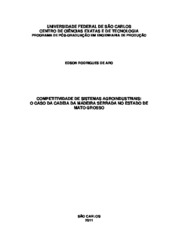Competitividade de sistemas agroindustriais: o caso da cadeia da madeira serrada no estado de Mato Grosso
Abstract
The Brazilian forest agribusiness represents for 5% of GNP, 17% of agribusiness exports and 8% of total Brazilian exports. In this context, the State of Mato Grosso is no stranger to challenge the country in becoming competitive and sustainable in the long term in this sector. The state of Mato Grosso accounts for about 12.2% or 1.47 million cubic meters of wood production in logs of a national production of 14.12 million cubic meters coming from the native forest, and the second largest domestic producer in 2008 . The chain of wood from Mato Grosso is responsible for the production of logs, lumber, strips, sheet of plywood and others. The research goal was to identify and evaluate the factors of competitiveness of chain of lumber as a way to bring public and private politics aimed at increasing the competitiveness of this system. The methodology uses drivers identified as technology, inputs and infrastructure, management of production units, institutional environment, market structure, governance and environmental sustainability. For the drivers of competitiveness is attributed valuations ranging from very unfavorable to very favorable for sub-factors identified for each driver. Through the rapid appraisal method were interviewed key agents in the chain of lumber by conducting semistructured, as it required information from secondary sources. The lumber-producing regions are located in the central region (Pólo Sinop) northern region (Pólo Alta Floresta and Guarantã do Norte) and northwest (Pólo Aripuanã and Colniza). We conclude that the determinants of competitiveness are: institutional environment and environmental sustainability. The forest management in a sustainable manner becomes conclusive for the chain in the production of lumber in a competitive and sustainable way. However, the chain of lumber needed to reconcile public interests, NGOs, representatives of class and private companies.
